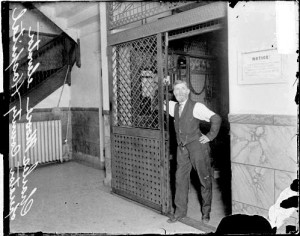Browsing the shelves the other day, looking for something completely unrelated, I stumbled across a 1905 treatise (its second revised edition) written by a St. Louis attorney named J. A. Webb titled The Law of Passenger and Freight Elevators (or, more succinctly on the book’s spine: “Webb on Elevators”). Not realizing that a volume had been written on such an esoteric topic, I decided to take a look.
Webb, as it turns out, was rather prolific. In addition to elevators, he also wrote another treatise on interest and usury; edited a digest of Tennessee cases; revised editions of previous authors’ treatises on subjects including assignments, negligence, and torts; contributed to numerous law journals of the time; and lectured on torts at St. Louis’s Benton College of Law, which was established in 1896, the same year that the elevator treatise’s first edition was published. Alas, the Benton College of Law is no longer with us; the best I can tell, its most famous graduate was William McChesney Martin, the chairman of the Federal Reserve 1951-1970.
In any event, modern elevators were a relatively new thing. The first Otis passenger elevator was installed in 1857. It didn’t take long for a new law of elevators to begin to take shape. Perhaps unsurprisingly, the most common pre-existing law to be applied in the context of elevators was the law of common carriers.
The first chapter of Webb’s treatise is devoted to elevators as carriers. Subsequent chapters cover construction; operation; injuries; pleadings and practice; and damages. The book specifically exempts grain elevators from its coverage, as “grain elevators are more of the nature of bailees than of carriers…” (§ 14).
Among other highlights:
- It is the duty of the elevator’s operator to announce the car’s arrival at the floors requested (§ 102).
- It was a question for a jury whether an 8-1/2-year-old child could be held contributorily negligent for “thrusting its head into an elevator shaft.” (§ 104).
- The duty owed to a passenger riding on a freight elevator is similar to that owed to a passenger on a freight train. (§ 156).
- The age required to operate an elevator was different from state to state: 14 and older (Pennsylvania); 15 and older (Massachusetts, New York), 16 and older (Minnesota; Wisconsin). Massachusetts, Minnesota, and Wisconsin also required the operator to be 18 or older if the elevator was capable of speeds over 200 feet per minute.
Webb on Elevators is available on the 9th floor of the Library, at call number KF5705 .W4 1905. It’s also available in the Library’s online subscription to The Making of Modern Law (myIIT password required).

